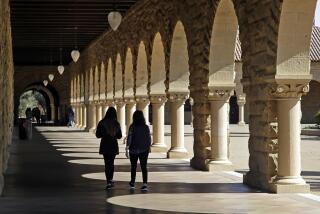Internet’s Hate Sites Can Be Hidden, but They Can’t Be Ignored
- Share via
When I agreed to write a column about hate sites on the Internet, I knew that it would be an unsettling experience. But I had no idea just how disturbing it would be.
When I researched this topic about three years ago, I found some pretty unsavory sites. But this time I found a lot more, and some, frankly, were nauseating.
One was operated by the Church of the Creator, the group that 21-year-old Benjamin Smith was part of until shortly before he embarked on a killing spree in the Midwest that ended when he took his own life. That site was bad enough, but there are hundreds more like it. The Los Angeles-based Simon Wiesenthal Center (https://www.wiesenthal.org), which tracks hate sites, identified more than 1,400 “problematic” Web sites as of March--twice as many as it found the year before. Even that number may be conservative. Rabbi Abraham Cooper, the center’s associate dean, estimates that there may be as many as 2,100.
I’m not going to go into vivid detail about what I found after looking at about 20 of these sites, but even I was shocked--and I have pretty thick skin. I expected to find Web sites that ridicule African Americans, Jews, gays, immigrants and others, but some took it a few steps further by combining bigotry with articles about guns, bombs and other implements of violence.
Others were designed deliberately to shock, with displays of swastikas, burning crosses and nooses. One site mixes hate with stories and photographs that celebrate sex and violence in the most extreme way imaginable.
What’s most disturbing about these sites is that they’re very easy to find. Unlike most pornography sites, the people who run hate sites don’t usually put up even a feeble effort to keep out children. On the contrary, some overtly invite children and teens to participate. The Church of the Creator Web site had a children’s section complete with puzzles and a coloring book. Another site has a “kids page” that is reportedly maintained by a 10-year-old. Many have music graphics and rhetoric designed to appeal to teens.
*
What can we do about this? We can’t ban hate sites because it’s impossible to take away the 1st Amendment rights of bigots without jeopardizing the free speech rights of the rest of us. Some people argue that we should place limits on free speech, but even if we could agree on where to draw the line, many of the subtler and seemingly reasonable sites would slip through. In fact, some of the most dangerous sites don’t even look like hate sites. They contain what appear to be reasonable--albeit misguided--scientific and historical arguments that, if believed, could lead young people and others to conclude that target groups really are inherently inferior or dangerous.
I don’t think the government can or should do anything to ban these groups from the Internet, but there are things that individuals and groups can do to shield or inoculate children from them.
One option for parents is to install a filtering program that blocks sites advocating hate or violence. Most of the programs designed to keep kids away from pornography can also be configured to keep them out of known hate sites. The Anti-Defamation League (https://www.adl.org) has teamed up with the Learning Company to produce a special version of CyberPatrol called the ADL HateFilter, which blocks hate sites and “encourages parents to teach their children about the nature of bigotry and the hatemongers who promote it.” The program, which runs on Windows, costs $29.95. A seven-day free trial version can be downloaded from ADL’s Web site.
With or without filters, it’s important for parents to talk with their kids about hate sites and bigotry in general. David Lehr, Pacific Southwest regional director of the Anti-Defamation League, recommends that parents “sit with your kids and point out the logical inconsistencies and danger of hate.” He suggests that you “use these sites as teachable moments.”
Rabbi Cooper agrees. Because kids are more Net-savvy in many cases than grown-ups, they may actually be more likely to know about hate sites than their parents. “Ask the kids to take a half-hour to show you the stuff,” he suggests. “It’s a good point of departure to sit down with your child to talk about these issues.” You also can use this time to talk about music and other media that celebrate violence or degrade women, gays, minorities and others.
I agree with Lehr and Cooper. But even if you are 100% successful in inoculating your own kids from the influence of these sites, a lot more work has to be done. Not all parents will bother teaching their kids about the dangers of hate, and some even encourage it. Even those of us who believe we can help keep our kids from becoming bigots can’t necessarily prevent them from becoming victims of bigotry.
*
After spending three days wallowing in other people’s racist, sexist, homophobic, anti-Semitic, anti-Catholic and anti-immigrant propaganda, I’ve come to the conclusion that the only way to drown out this type of hate speech is through a massive education campaign that encourages our society--especially our youth--to think critically and question anyone who blames their problems on people who look, act, speak or think differently. Web sites operated by ADL and the Wiesenthal Center are a good starting point for ideas.
This is one area in which we all have responsibility for everyone’s children. Schools, religious organizations, civic groups, the media and political leaders of all persuasions--and even computer columnists--have a moral obligation to teach tolerance.
Lawrence J. Magid can be heard at 1:48 p.m. weekdays on KNX-AM (1070). He can be reached at larry.magid@latimes.com. His Web page is at https://www.larrysworld.com. On AOL, use keyword “LarryMagid.”






